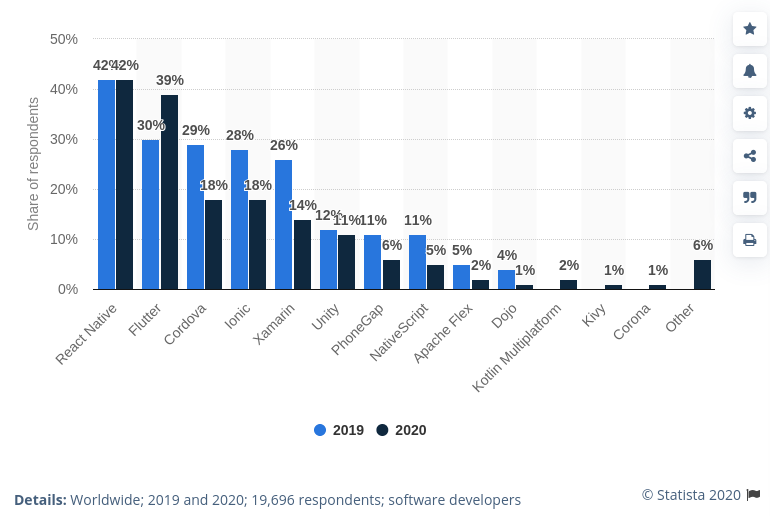Where Is Cross-Platform Development Heading on Mobile Devices?
Which Should We Choose in 2020?
📅 2020.10.06 - 👤 Borbély Viktor
In recent years, the use of so-called cross-platforms for mobile app development has become increasingly widespread. What’s good for everything is really good for nothing, holds the common saying. However, there are situations when these tools are unbeatable.
Cross-platform or multi-platform means that the application is completed simultaneously for Android, iOS (Windows Phone???). From this, it’s palpable that it’s advantageous for the developer because it’s sufficient to create the application once, and the task is largely done. The client’s interest is closely related to this, as precisely half as much developer work must be paid for compared to having it made natively for each platform separately.
 Based on statista.com’s report, React Native and Flutter frameworks are the most popular in 2020
Based on statista.com’s report, React Native and Flutter frameworks are the most popular in 2020
I created this summary based on thedroidsonroids.com’s article.
Popular mobile cross-platforms
The above figure shows that Flutter (39%) lags slightly behind React Native (42%). The latter clearly brought the growth situation between years.
Business owners always want to know the answer to some critical questions:
- Which fits my project best?
- Which solution brings the best Time-to-market time?
- Will my app be reliably stable and user-friendly?
- Which will be best if I want a pixel-perfect appearance?
From the article, it turns out that based on the fan base, the two frameworks are neck and neck. React Native was released by Facebook in 2015, which assumes a more mature framework. However, this was caught up by now by Google’s Flutter beta release in 2018.
In knowledge, they are difficult to distinguish, there are minor differences. Both run natively on the phone, this is visible in excellent performance. Occasionally even exceeding it. Of course, this has a price in application size. This is perhaps negligible today, but worth mentioning.
Which one is used by whom is almost a matter of taste. It can be determined that if the developer previously programmed websites, then React Native’s JSX language will be more at hand. Flutter’s Dart language is modern, lovable, and easy to learn.
Buttons, lists, etc. bring the usual appearance for the given OS. Material Design on Android and Cupertino Design on iOS. So the feeling and appearance are completely the same.
Where Flutter stands now
I previously wrote about the Flutter framework and its advantages. The few months since have brought further innovations. Tracking Android 11’s summer and iOS 14’s autumn arrival. Immediately reacting to changes, practically within days, the follow-ups that the OS required came out.
Apps made in Flutter:
- Xianyu app – Alibaba (App on App Store,App on Google Play) – Alibaba is the world’s largest e-commerce company
- Hamilton app (App on App Store, App on Google Play, Website) – the Broadway Musical’s official app
- Google Ads app (App on App Store, App on Google Play)
Reflectly (App on App Store, App on Google Play, Website)
- JD Finance app – leading digital tech company (App on App Store)
- Abbey Road Studios Topline app (App on App Store, App on Google Play)
Apps made in React Native:
- Skype
- Tesla
- Fb Ads Manager
Every app owner’s nightmare
It’s clearly visible that the last decade and a half has produced many solutions so that mobile apps can be made as simply, seamlessly, or precisely by reusing our knowledge. A cross-platform has numerous advantages in mobile development.
Despite all this, an evergreen topic on forums is what will happen if these frameworks are closed or made paid. What will happen if Apple suddenly doesn’t let in non-natively written applications? (Apple can be quite hair-splitting with its acceptance guidelines anyway.)
Well, seeing Google’s almost weekly announcements, this is not expected, at least in the short term. By capturing both mobile operating systems, and further opening the doors to Linux, Mac, and Windows desktop developments for developers. (They jointly announced cooperation with Microsoft in recent weeks.)
We should definitely be aware of one big advantage: it’s the framework developers’ task to mesh with the given operating system. The developer doesn’t have to deal with this, spending long hours searching for a bug. This increases productivity.
Where to from here?
It’s visible that Flutter is still at the beginning of its career. This curve is on the ascending branch. It cannot even be predicted when it will reach its peak. The determination on Google’s part is visible. Since there’s still something to polish on alpha/beta support, this will take a while.
But who knows. In IT, one thing is certain that it constantly evolves. Things become obsolete in a few years and something new must be learned. One day a better, more beautiful framework will come that similarly captures developers’ hearts.
Every developer needs knowledge of a popular cross-platform for mobile development. Whichever it may be.